"We often forget that we are nature. Nature is not something separate from us. So when we say that we have lost our connection to nature, we’ve lost our connection to ourselves." - Andy Goldsworthy
"Sarvam, Sarvatmakam - Everything is related to the whole" - Vyasa, Yoga Sutra Bhasya
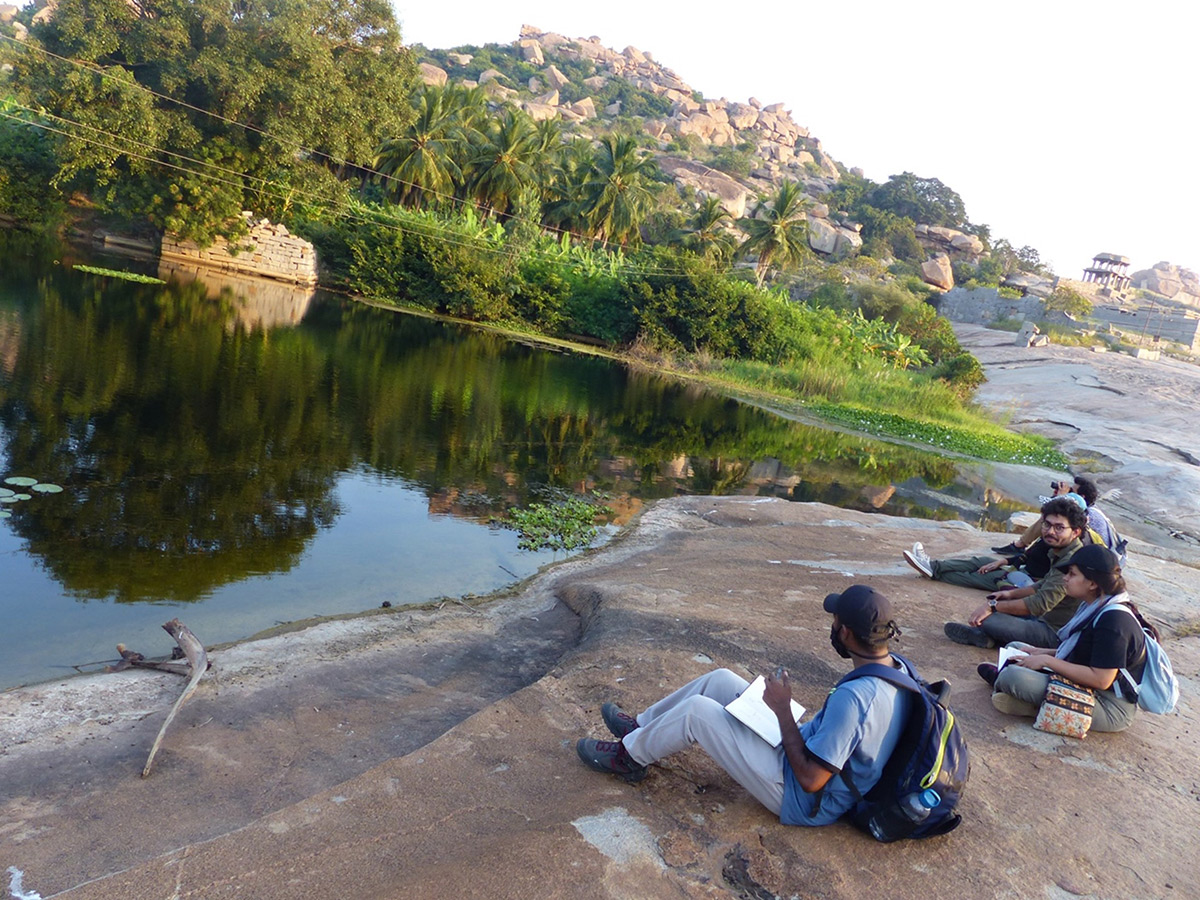
Students sketch a pond ecosystem at Hampi, Karnataka. PC: Srivi Kalyan.
Vision
The Earth Education and Communication course at Srishti Manipal encourages students to get inspired by the relationships they personally form with the natural world as a complex system of interdependence and co-existence amidst survival and sustenance. We observe and investigate the porous boundaries that connect the human and more-than-human worlds with wonder and celebration. Most environmental concerns do not fit neatly into any one disciplinary knowledge system. We place significant value on interdisciplinary and transdisciplinary problem solving.
While there are many worldviews and contentious viewpoints in allied fields that deal with environmental issues, in this course we critically inquire into "being human" and if it is possible to achieve a symbiotic relationship with the evolving natural world around us. We see humans as a species powered through centuries of evolution and the environment, a piece in a complex intricate puzzle and not at the top of the food chain or at the apex of power.
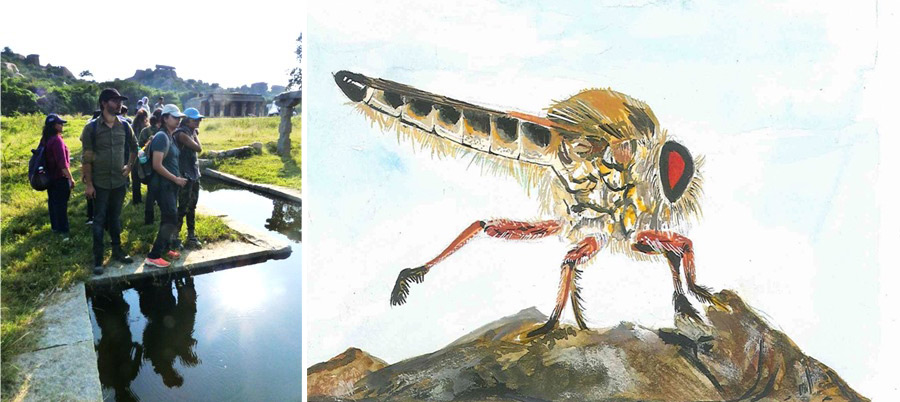
Students study the ecosystem in the built environment at a temple tank in front of the Vitthala Swamy Temple, Hampi, Karnataka; Yuganshika Garg sketches a robberfly.
We choose to ask-
- As an intelligent species how do we consciously engage with the natural world at work around us?
- Can we create symbiotic relationships that are driven by the intelligence of the body in its sensorial relationships with life?
- What are the ethics and philosophies that can help us engage with conflicts, painful realities and contentious debates?
- How can art, design and technology be used to push the boundaries of ecological discourse and create points for action?
- What can traditional practices from different cultures offer in the way of wisdom to all that we grapple with in environmental issues today?
These and more questions serve as a guide map to engaging with and creating within this program. This course is an attempt to explore how polarised, `silo-ised’ views in conversations and debates around environmental issues can be made to gradually come together and overlap, dissolving discipline based perceptions and preconceived ideas, allowing for new discourses to emerge.
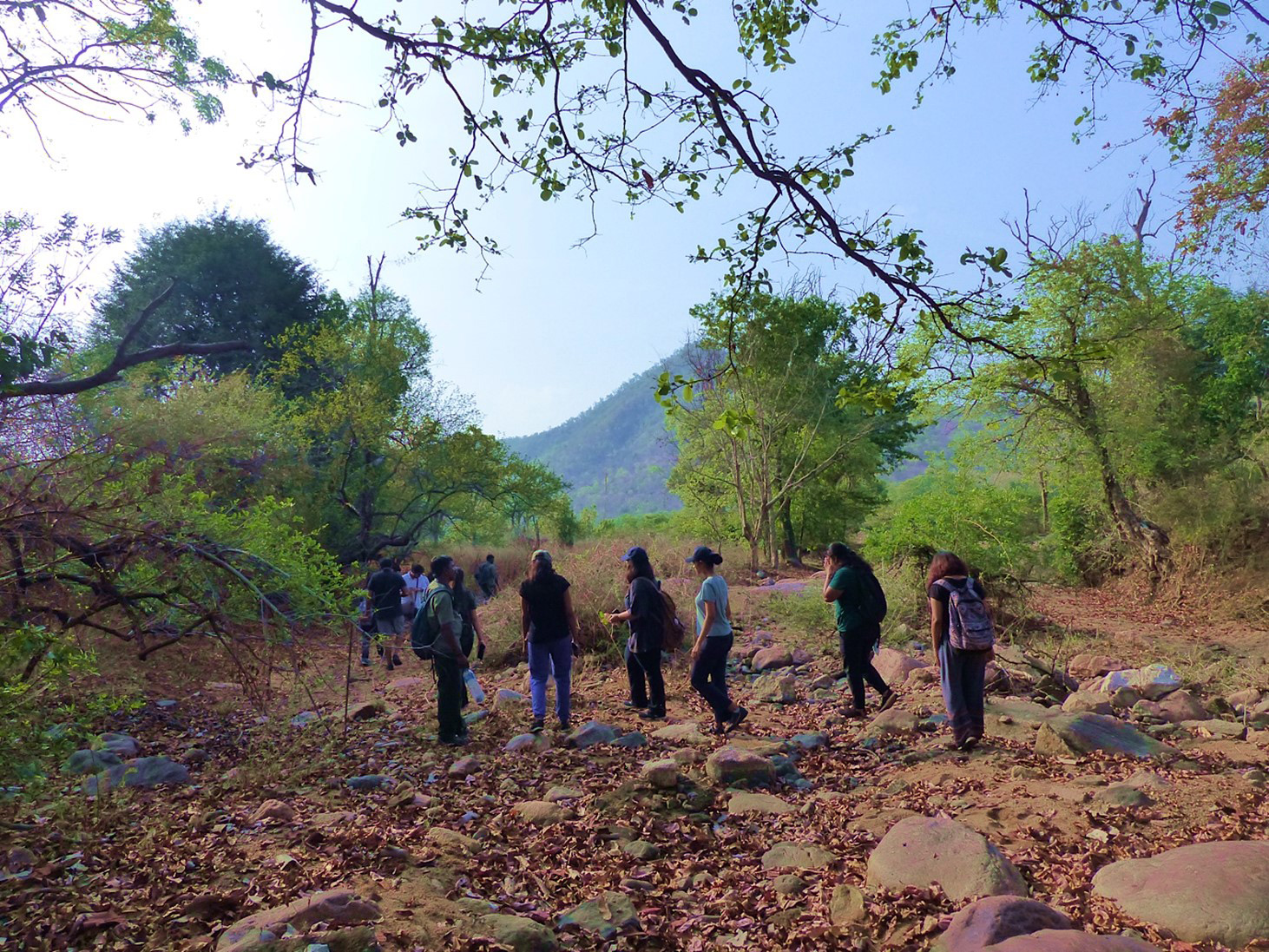
Students trek in the Cauvery landscape to understand the ecology of the river and closely observe biodiversity, Galibore, Karnataka. PC: Srivi Kalyan.
This course focuses on experiential learning and deep engagement with specific sites to develop context –sensitive and reflexive frameworks. Trekking, hiking, field work, nature journaling, and engaging with diverse habitats are an integral part of the program. It also builds theoretical frameworks that support students in understanding contextual and critical perspectives in this area of work. In these sites, an exploration is about a hands-on engagement with people and their lives, local flora and fauna and the land itself. As Jane Goodall articulates “Only if we understand, can we care. Only if we care, we will help. Only if we help, we shall be saved.” The axis of the course revolves around Self & Contemplation, Context Sensitivity, Environmental Stewardship and Ecological Consciousness.
This course is open to art and design practitioners and non-practitioners alike. We believe in creating student cohorts from diverse disciplines to allow for critical debates, engagements and new discourses. The goal of this course is to inspire people from diverse disciplines who seek to build their practices in an ecological frame. It is for people who desire to inspire intrinsic action through their communication methods, using diverse media, educational interventions and lived experiences. The impact of this deepening awareness is finally seen in art and design solutions, thought frameworks, critical discourses that emerge, transdisciplinary thinking, and involved engagement that is context sensitive and reflective. It also reflects in fostering long-term relationships with people and organizations on the ground. Through this course, we hope dissolving boundaries will open new relationships with LIFE in all its diversity and wonderment embedded in ecological consciousness.
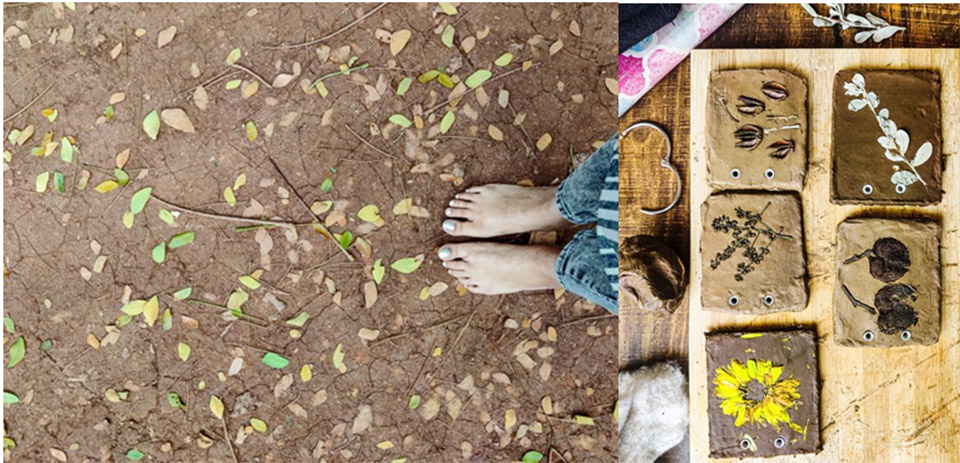
Sneha uses diverse approaches and play with material to develop her own ideas of eco-art.
Course Structure
- Disciplinary and Interdisciplinary studios
- Workshops
- Seminars
- Lines of Inquiries (Field work, Case Studies, Investigations, individual or Group Projects, Transdisciplinary Research)
- Theory and Understanding
- Independent Study
- Open Elective
- Practice
- Exhibitions
- Culminating Performances of Understanding (Portfolio, Transdisciplinary research, Projects, Colloquium, Capstone/Dissertation)
- Knowledge Enhancement (ability or skills)
Learning Approach
Learning in at the postgraduate level is driven by published lines of inquiries that is enacted through studio-based learning, workshops, theoretical reflections and field work. This approach cultivates a creative practice through engagement in diverse contexts, collaborative and participatory approaches leading to knowledge development.
Program learning approaches include:
- Designed as case studies. To foster a deep understanding of biogeography, human geography, state policies, local communities and livelihood practices, endemic and native species of flora and fauna by immersion in one or more sites.
- Immersion at site and designed for action. To take the learnings from immersive field trips and expeditions; and extend, deepen and transform them into action.
- Participatory approaches. To understand the diversity of a space and those who inhabit it in a deep and nuanced way, over a period of time, using well designed sensitive and equitable tools and methods.
- Project Based Learning. To actively explore real world challenges, conflicts and problems within timelines with context-sensitivity.
- Art and Design Research Methods: To engage with art and design research methods to push the boundaries of discourses in conservation, ecology, eco-ethics and eco-philosophy and eco-aesthetics.
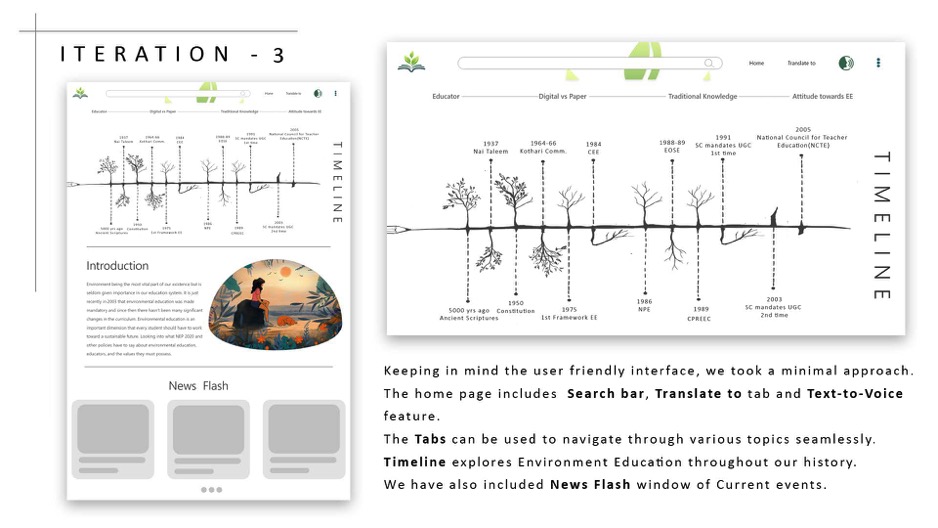
A team of four students map the environmental education timeline in India and look closely at the National Education Policy to investigate and understanding the challenges of environmental education.
Capability Sets
- for deep reflection as a way to review biases, contemplate and engage with life in all its forms
- to be discerning with a critical understanding of diverse positions and movements that inform environmental conservation and education
- to transact meaning with audiences and build context-sensitive practices
- to perceive gestalts, navigate complexity and negotiate intelligences through transdisciplinary engagement.
- for leadership as action in art, design and/or technology praxis
- for responsible creativity that emerges from social, ecological, ethical and learning design
- to reflect on interdependence and co-existence that we share with the natural world
Opportunities
The above mentioned capability sets could lead to opportunities such as:
- Curators in museums and galleries.
- Work with publishing houses, design studios, to create awareness campaigns, environmental films and documentaries.
- Design teaching and learning aids that foster environmental sensitivity.
- Work at NGOs/ organizations that work with social and ecological concerns.
- Continue your art/ design practice, be an entrepreneur or a design consultant with a strong environmental ethic.
- Work in zoological parks and aquaria.
- Pursue your research and continue to do a PhD.
- Develop your own projects and apply for grants.
Some jobs profiles could be
Design Strategist, Project Manager – Community Program Services, Entrepreneur- Visual Designer. Artist. Arts Manager, Design consultant, Environmental Educator, Social & Eco-justice Coordinator, Multicultural program coordinator, Cultural Design Practitioner, Creative Director, Program Manager, Creative and Cultural Researcher, Storyteller, Systems designer/ Consultant, Design Consultant, Educational designer, Eco-artist/ Eco –Designer
People
Enquiries

Disciplinary Intersections
The program in Earth Education is informed by the following learning disciplines:
Critical Geography
Ecology and Environment
Environmental graphics
Experimental Media Arts
Film
Information Technology
Language Arts
Mathematics and Physical Sciences
Photography
Policy Studies and Environmental law
Sustainable Studies
Systems Design
Textile Arts
Urban Studies and Design
Visual Communication Design
Research and Collaboration
The program is closely linked with a wide range research and practice spaces:
Centre for Reimagining Transitions (CRT)
Design EARTH
LeNS Lab
Odde Research Center
Srishti Films
UNESCO Chair
FAQs
Earth Education and communication encourages thinking about co-existence and interdependence while navigating complex issues concerning the natural world. It allows one to build perspectives and think through the complexity of issues related to the environment from the point of view of other species and rooted in ecology, various positions and movements in environmental history, and at the meeting point of economics and ethics. Further, it allows one to engage with art, design and technology through the units to present and communicate complex information in a meaningful manner to support discovery and communicate information across a range of environmentally relevant issues.
Through the course, one is introduced to diverse media and data that range from the artistic, informative to the technological and encourages them to find their own forms for communication and curating experiences. The core of this field lies in perception and interpretation of information in order to communicate. Communication can be personal, artistic and creative, it can also move into the space of a designer and expand into social communication and advocacy. Contemporary, exploratory and evocative, EEC offers space for crafting creativity and communication in a time of ecological crisis.
People in this field are cross pollinators. They can grasp the crucial links in any context from their roots in understanding environmental issues, contentious debates, problems of growth and development, and justice in relation to all beings. They can curate and design information, communication or educational programmes with the knowledge base they build. Driven by a desire to connect and evoke, they are willing explorers of simple and complex contexts alike. From environmental issues to human rights, from civic media to information visualization, from puppetry to web-design, their breadth and range of work are varied and experimental driven by the contexts they choose to work in. They take communication to a new level in their ability to work across diverse fields through varied visualizations and technical explorations embedded in an ecological consciousness.
By opting for this course, one can evolve highly independent practice; ideate with far-reaching insights in whatever positions they choose to work in. From environmental to social communication, Educational design, creative arts and design to technology based fields, advisory roles for corporates, graduates of this program have a wide and diverse playground to explore and find their niche.
Anyone who is willing to engage with the natural world and communities, analyze, evaluate and deepen their practice with relevance to contexts can become an EEC practitioner. Being willing to embrace diverse kinds of media would be critical to developing educational or communication models, frameworks and engagements. If you are someone who is not completely satisfied with the idea of being an artist or a designer or environmentalist but feel that you want to bridge these worlds, this could be very relevant course for you. Further if you are someone who is keen to understand the contentious debates and approaches that surround working with the environment, your will find this course providing critical perspectives to help you find your own voice. The goal of this course is to inspire people from diverse disciplines who seek to build their practices in an ecological frame.
At Srishti Manipal, we particularly focus on issues, contexts and communities that have social and environmental relevance. If you are someone who is looking to make a difference in these areas and have a strong passion to tackle wicked problems, this would be a good fit for you.
An EEC practitioner would benefit from an inherent inclination to explore and understand the natural world and the diverse human relationships within it.They would benefit from practicing and engaging with different media and modes of representation. These could range from drawing and painting media to performing arts, technology and softwares,engineering, writing and graphic design. An EEC practitioner essentially plays with diverse forms of representation to create new ways to engage people in an ecological frame. Their strength lies in this diversity and a deeper understanding of symbiotic relationships in the natural world. Reflective storytelling is an essential skill that cuts across all the diversity in this program and becomes the core essence of communication. A willingness to traverse across disciplines are attitudes that will hold the EEC practitioner in good stead.
The focus of this course is to critically inquire into "being human" and if it is possible to achieve a symbiotic relationship with the evolving natural world around us; Value life with empathy, integrity and deep perception of all the interconnections and politics that allow life to co-exist on this planet. The key need is to learn to appreciate enduring and overarching values and principles of life and engage with wisdom traditions to interpret contexts, communities, the more-than-human world, data, information and creativity.
Communication and interpretation of information using diverse media, formats and methods with these ideas of symbiosis is an important aspect of this course. We work with art, design and technology to deal with wicked problems, contexts, and communities in the integrated spaces of social, environmental, economic and political issues.
An EEC practitioner would benefit from an inherent inclination to explore and understand the natural world and the diverse human relationships within it.They would benefit from practicing and engaging with different media and modes of representation. These could range from drawing and painting media to performing arts, technology and softwares,engineering, writing and graphic design. An EEC practitioner essentially plays with diverse forms of representation to create new ways to engage people in an ecological frame. Their strength lies in this diversity and a deeper understanding of symbiotic relationships in the natural world. Reflective storytelling is an essential skill that cuts across all the diversity in this program and becomes the core essence of communication. A willingness to traverse across disciplines are attitudes that will hold the EEC practitioner in good stead.



